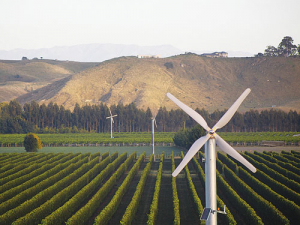Damaging frosts typically occur after a cold, cloudy day followed by a still night with clear skies.
The earth quickly radiates any stored heat after sunset and an inversion layer occurs -- the air being coldest near the ground with a warmer layer of air above it.
The degree of crop damage depends on the minimum temperature reached, the rate at which the temperature falls and the amount of time below a critical temperature. Critical temperature is defined by Young (1966) and Johnson and Howell (1981) as “the lowest temperature a bud (or shoot) can endure for 30 minutes or less without injury”.
However, it’s not all about avoiding catastrophic loss; the aim is also to protect against cold injury to increase a grower’s current yields and improve the quality of the fruit while ensuring continuity of supply or shelf space.
Assessing frost risk is the first step; site selection is still the key to lowering frost risk. Crops become more susceptible to frost damage when they are located at high elevations, in low lying areas where cold air settles and next to obstacles to air movement such as tall vegetation, levees and buildings.
Orchard design should allow for orienting trees in the direction of predominant slopes to promote air movement down-slope and through the orchard. In flatter areas, orient trees in the direction of the prevailing wind.
After selecting the location and orchard design/orientation, methods to protect against frost and cold injury fall into one of four main groups: wind (frost fans or helicopters), water sprinkling, heat introduction and orchard management/maintenance practices (such as removing ground cover).
Frost fans are a well proven technology for mitigating the devastating losses. Many growers use them as a tool to combat cold injury by programming them to start, based on a preset temperature, helping to prevent damage from events that may only last a few hours in the middle of the night or early morning.
Frost fans work by utilising warmer/drier air from the ‘inversion’ layer to create air movement at the fruiting/flowering height in orchards on still, cold nights, preventing damage to flowers, soft tissue and fruit. Anecdotal evidence from growers has shown that while the use of frost fans can save a crop from total loss in a severe frost, they can also play a significant role in improving the yields and quality of fruit that can slowly be eroded by several previously unrecognised cold snaps.
New Zealand Frost Fans Ltd (NZFF) manufactures a range of frost fans (aka wind machines) under the FrostBoss trade mark, including the C24 (2-blade), C39 (3-blade), C49 (4-blade) and FrostBoss C59 (5-blade) machines. The FrostBoss C49 (4-blade) machine is claimed to be the best-selling frost fan in NZ and Australia.
The FrostBoss C49 was developed with help from former Team New Zealand aerodynamics research engineer Richard Karn, to optimise noise reduction by using a greater blade working area and slower rotational speed than a 2-blade fan. In addition, the much higher blade passage frequency of the 4-blade fan means the noise signature no longer has a low frequency beating sound, such as with an Iroquois helicopter.
Along with the FrostBoss C49, the FrostBoss C59 (5-blade machine) is the quietest on the market.
Fan upgrades can improve efficiency and productivity, such as by retrofitting composite blades, centrifugal clutches and gearboxes, particularly when coupled with automated controllers and web-based monitoring.
www.nzfrostfans.com



















